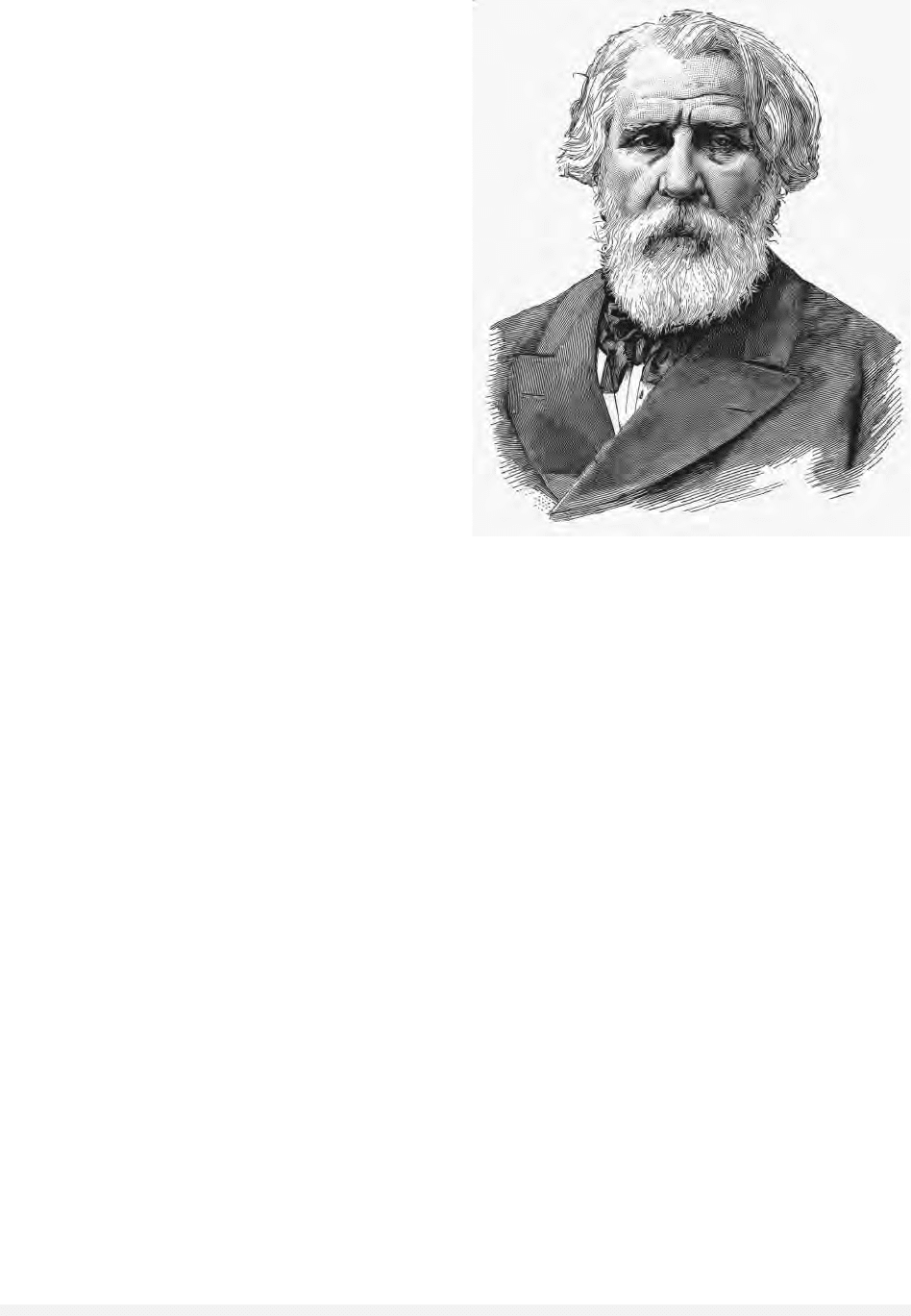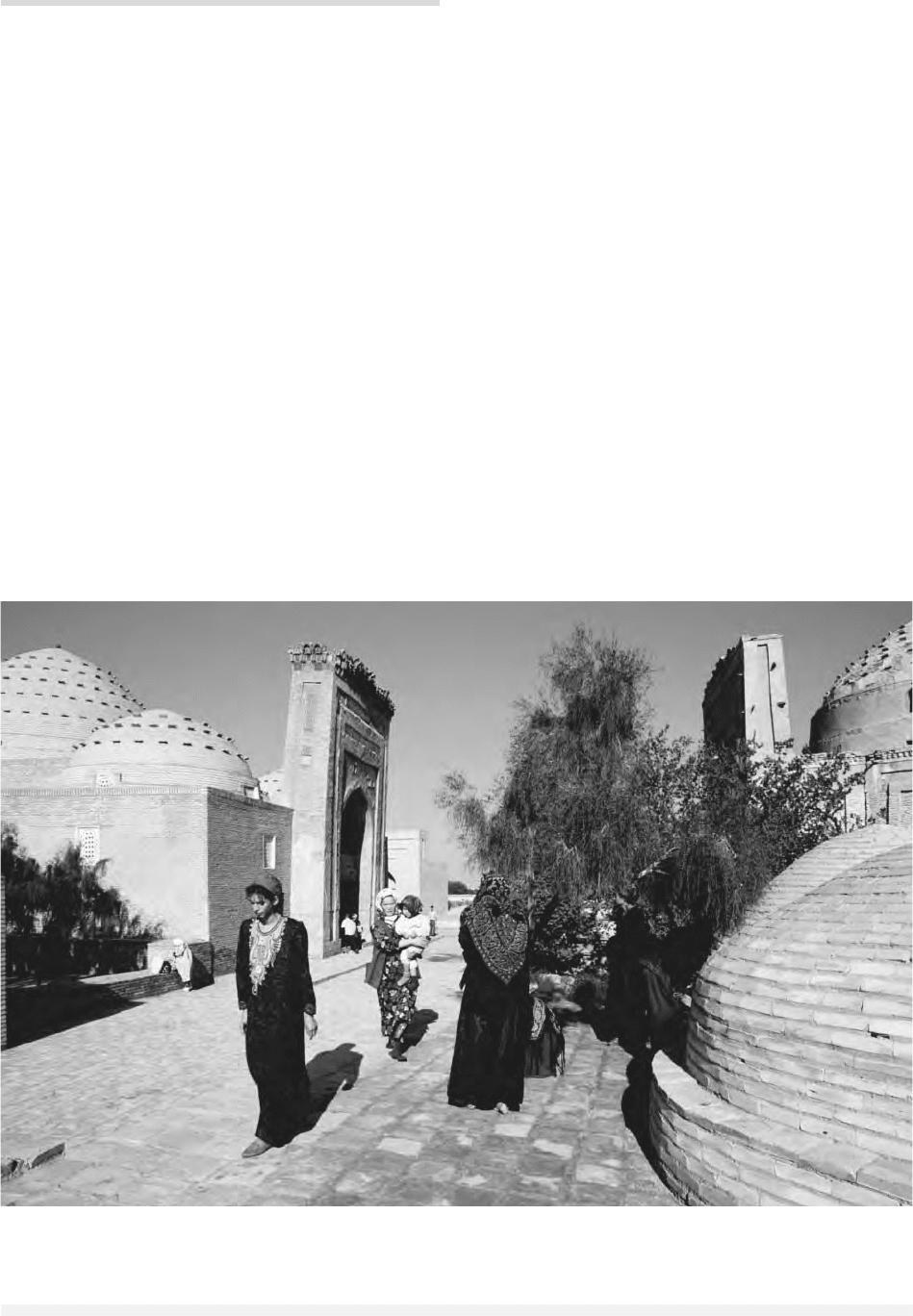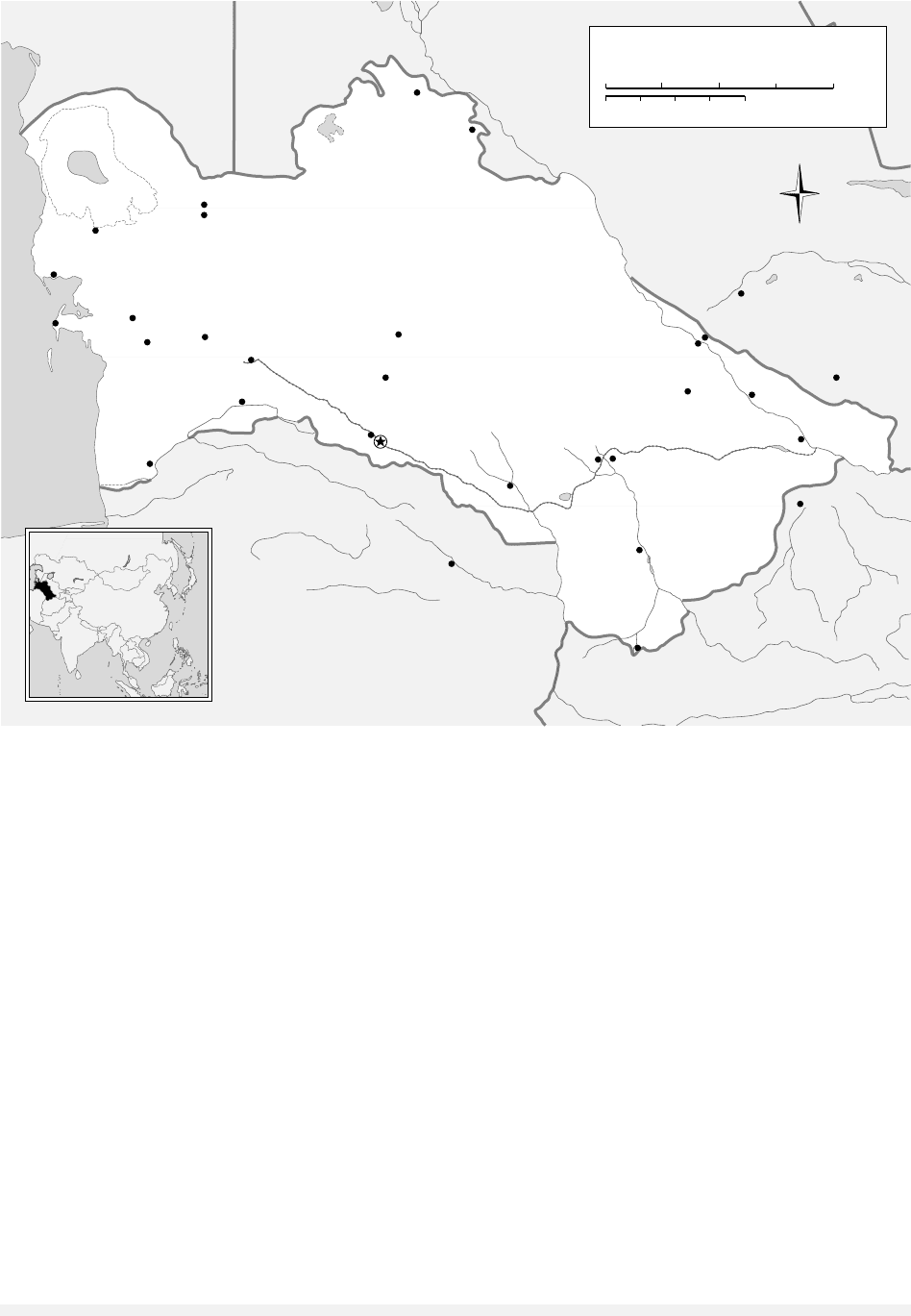Encyclopedia of Russian History
Подождите немного. Документ загружается.


TUGAN-BARANOVSKY, MIKHAIL
IVANOVICH
(1865–1919), political economist and social theorist.
The most significant prerevolutionary Russian
and Ukrainian contributor to economics, Tugan-
Baranovsky was born near Kharkov, Ukraine, and
attended Kharkov University. As a leading member
of the Legal Marxist group, Tugan attempted to re-
form orthodox Russian Marxism by adding a large
dose of neo-Kantian ethics, together with insights
from British classical economics and a dash of the
German historical school. In economic theory Tu-
gan’s most significant work was Industrial Crises
in Contemporary England (1894). This pioneered the
detailed empirical description of trade cycles—to-
gether with concern for their social consequences—
alongside a theoretical explanation combining
maldistribution of income, disproportion between
industrial branches, and a mechanistic steam en-
gine analogy using free loanable capital as the mo-
tor force. This approach influenced Western
macroeconomic theorists such as John Maynard
Keynes, Dennis Robertson, and Michal Kalecki.
Tugan also wrote a major work examining the
history of the Russian factory using legislative and
business history sources, a widely read account of
the principles of political economy, and a study of
cooperative institutions. In addition, Tugan made no-
table contributions to social theory, monetary eco-
nomics, conceptions of socialist planning, and the
history of economics. Towards the end of his life Tu-
gan’s allegiance shifted from Russia back to Ukraine,
and he was Ukrainian Minister of Finance from Au-
gust to December 1917. During 1918 he helped to
establish the Academy of Science in Kiev, and died on
a train headed for Paris the following year.
See also: INDUSTRIALIZATION
BIBLIOGRAPHY
Barnett, Vincent. (2001). “Tugan-Baranovsky as a Pio-
neer of Trade Cycle Analysis.” Journal of the History
of Economic Thought 23(4):443–466.
Crisp, Olga. (1968). “M.I. Tugan-Baranovskii.” In Inter-
national Encyclopedia of the Social Sciences, ed. D. L.
Sills, vol. 16. New York: Macmillan.
Tugan-Baranovsky, M. I. (1970). The Russian Factory in
the Nineteenth Century, tr. Arthur Levin and Cleora
S. Levin. Homewood, IL: R. D. Irwin for the Amer-
ican Economic Association.
V
INCENT
B
ARNETT
TUKHACHEVSKY, MIKHAIL
NIKOLAYEVICH
(1893–1937), prominent Soviet military figure;
strategist, commander, weapons procurer.
Mikhail Tukhachevsky is one of the most im-
portant and controversial figures in the history of
the Soviet armed forces. Born into aristocracy, he
attended prestigious imperial military schools and
academies before joining the communist cause and
becoming a fervent Bolshevik. He served in World
War I and was taken prisoner by the Germans. He
escaped, and later commanded Red Army troops in
the civil war. Tukhachevsky held numerous im-
portant posts within the Red Army, including chief
of the Red Army Staff, Chief of Armaments, and
Commander of the Leningrad Military District. In
1935 he was awarded the highest military honor
of Marshal of the Soviet Union.
Tukhachevsky was an innovative and shrewd
military strategist who theorized combat scenarios
for future wars, created new means of employing
forces, and worked tirelessly for the implementa-
tion of his ideas into the rearmament and reform
of the armed forces. He incessantly called for more
resources to be devoted to rearmament, in spite of
numerous competing demands on limited resources
from other state sectors.
Tukhachevsky wrote many articles about mil-
itary tactics and strategy, the most important of
which was Future War (1928). This 700-page trea-
tise surveyed the combat potential of all countries
neighboring the USSR, offering a range of combat
scenarios in the event of war. Together with his
military colleagues, Tukhachevsky developed the
tactical force employment concept of deep battle.
This maneuver involved the use of tanks and air-
craft to penetrate deep into the enemy’s defense and
destroy his forces. The deep battle concept was in-
corporated into Soviet 1936 Field Regulations and
was utilized in the Red Army’s combat operations
against the German Army in the second half of
World War II. The deep battle concept also found
expression in NATO military doctrine in the 1980s.
Tukhachevsky’s contributions arguably rendered
him the most prescient and talented strategist in
the Red Army in the 1920s and 1930s.
While commander of troops in the Leningrad
Military District, Tukhachevsky worked closely
with designers and theorists to develop a variety of
new weapons and methods for employing them.
In addition, he mastered the technical details of
TUKHACHEVSKY, MIKHAIL NIKOLAYEVICH
1583
ENCYCLOPEDIA OF RUSSIAN HISTORY

complex weapons systems, from aircraft engines
to dirigibles and rocket propulsion systems.
Tukhachevsky also oversaw aspects of the secret
military collaboration with German aircraft and
chemical weapons experts, urging the Germans to
share more of their knowledge and experience than
they were sometimes willing. When tensions de-
veloped in Manchuria in 1931, presenting the
threat of war to the Soviet Union from East and
West, defense production became a higher priority,
and many of Tukhachevsky’s projects came to
fruition.
Tukhachevsky’s relationship with Josef Stalin,
who ordered his execution in 1937 during the Great
Terror, is controversial and unresolved. The origins
of the tension between Stalin and Tukhachevsky
have been traced to several events, documents, and
rumors. Possible factors include: conflicts between
Stalin and Tukhachevsky over the command of the
Battle for Warsaw in 1920; Tukhachevsky’s criti-
cism of the role of the cavalry army in the civil
war for which Stalin served as chief political com-
missar; Tukhachevsky’s warnings of the German
military threat to the USSR; and documents falsi-
fied by Germans or Czechoslovak agents alleging
Tukhachevsky’s intent to overthrow the Soviet
leadership together with Nazi forces.
See also: MILITARY, SOVIET AND POST-SOVIET; PURGES,
THE GREAT
BIBLIOGRAPHY
Alexandrov, Victor. (1963). The Tukhachevsky Affair.
London: MacDonald.
Samuelson, Lennart. (1999). Plans for Stalin’s War Ma-
chine: Tukhachevskii and Military-Economic Planning.
New York: St. Martin’s.
Stoecker, Sally. (1998). Forging Stalin’s Army: Marshal
Tukhachevsky and the Politics of Military Innovation.
Boulder, CO: Westview.
S
ALLY
W. S
TOECKER
TUPOLEV, ANDREI NIKOLAYEVICH
(1888–1972), patriarch of Soviet aircraft design.
Andrei Tupolev was one of the most important
aircraft designers in the Soviet Union during the
interwar period and was awarded the honor of
“Hero of Socialist Labor” three times in his career.
Tupolev is considered by many to be the father of
Soviet nonferrous metal aircraft construction, and
he developed more than fifty original aircraft de-
signs and over 100 modifications. In addition to
fighter aircraft and heavy long-range bomber air-
craft, Tupolev also designed aero-sleighs, dirigibles,
and torpedo boats. Educated at the prestigious Bau-
man Technical School in Moscow, he was one of
the founders of the Central Aviation Institute in
1918 and created a design bureau within it. He
spent most of his career at the design bureau and
in 1936 received orders from the Heavy Industry
Commissariat to transfer to GUAP (State Direc-
torate of Aviation Industry) as their chief engineer
who oversaw aircraft production. In May 1937,
Tupolev’s ANT-7 flew to the North Pole success-
fully. One month later, he was accused of being an
enemy of the state and was arrested for his alleged
role in espionage. After serving one year in regu-
lar prison, Tupolev was permitted to continue his
design work in a special prison as a means of avoid-
ing hard labor. Although his name was temporar-
ily withdrawn from public, his stature was
restored in the post-Stalin era.
See also: AVIATION
BIBLIOGRAPHY
Saukke, M. B. (1993). The Little-Known Tupolev (Neizvest-
nyi Tupolev). Moscow: Original.
Yakovlev, A.S. (1982). Soviet Aircraft (Sovetskiye samo-
lety). Moscow: Nauka.
S
ALLY
W. S
TOECKER
TURGENEV, IVAN SERGEYEVICH
(1818–1883), Russian novelist, playwright, and
poet.
Turgenev was born into an extremely wealthy
family on an estate with 500 serfs near Oryol, in
the Mtsensky uezd, in central European Russia. His
mother, a tyrannical shrew, savagely beat her serfs
and her sons and despised all things Russian. The
family spoke only French in the home. His father
was an attractive and dissipated rake. Turgenev’s
childhood nurtured in him an animosity toward
the institution of serfdom and a profound under-
standing of the culture of rural, aristocratic culture
of pre-Reform Russia—the very cultural wellspring
from which so many of the characters in his nov-
els were to emerge.
TUPOLEV, ANDREI NIKOLAYEVICH
1584
ENCYCLOPEDIA OF RUSSIAN HISTORY

Turgenev is nearly universally mentioned, along
with Fyodor Dostoyevsky and Leo Tolstoy, as one
of the great masters of the psychological novel, al-
though Turgenev himself disparaged more than
once the emphasis on psychological analysis that
marks the works of the other two members of that
triumvirate. Turgenev further distinguished him-
self from Tolstoy and Dostoyevsky by beginning
his career as a poet: his first major work was the
long poem Parasha, published in 1843—a year be-
fore Dostoyevsky’s entrée into literature and nearly
a decade before Tolstoy’s. Parasha was followed by
a handful of other significant verse works, though
Turgenev later wrote that he felt a nearly physical
antipathy toward his verse works.
Although his poetry was enthusiastically re-
ceived by Vissarion Belinsky, the leading literary
critic of the time, Turgenev’s first work of lasting
influence was a series of sketches of what Turgenev
knew first-hand from his childhood: the manorial,
rural, and peasant milieus. The brief, episodic de-
scriptions were initially published separately, be-
ginning in 1847, and then as a single work, A
Huntsman’s Sketches, in 1852. The work exercised
a profound influence on the public that is often
likened to that of Harriet Beecher Stowe’s Uncle
Tom’s Cabin, published the same year. Turgenev’s
work is one of the highest artistic quality—ex-
quisite, tightly crafted descriptions of the physical
world combined with engaging and complex por-
traits of peasants (generally positively portrayed)
and gentry (generally negatively portrayed).
Beginning soon after the death of Nicholas I in
1855, Turgenev, always sensitive to the winds of
change, wrote his four most significant novels:
Rudin (1856), Home of the Gentry (sometimes trans-
lated, more literally, as Nest of Gentlefolk) (1859),
On the Eve (1860) and Fathers and Sons (more pre-
cisely Fathers and Children) (1862). All are pene-
trating chronicles of the quickly shifting alliances,
mores, and institutions that marked the initiatory
period of the Great Reforms, with all its optimism
and surety of a brighter future. The greatest of
these, Fathers and Sons, depicts the intergenerational
conflict between the liberal men of the 1840s, with
their refined, European (more specifically, Gallic)
sensibilities and an inclination toward incremen-
talism in social and political change; and the new
people of the younger generation, nihilists (a word
Turgenev brought into coinage), men of science
who embraced German-inflected positivism, dis-
paraged aesthetics per se, and believed in the cre-
ative potential of destruction. The older generation
found Turgenev’s portrait of their brethren dis-
missive and patronizing, and the younger generation
found their reflection insulting and patronizing.
Turgenev, criticized from nearly every political an-
gle, responded by quitting Russia for Western Eu-
rope. From his refuge in Baden-Baden, Turgenev
wrote Smoke (1867), a venomous satire that at-
tacked, inter alia, the radicalized intelligentsia in
exile, the Europeanized Russian aristocracy, and the
conservative Slavophiles.
Poems in Prose, Turgenev’s final work, sealed his
reputation as the first Russian stylist. The final
poem famously praises the Russian language as
great, powerful, truthful, and free, a tribute per-
haps nowhere truer than when the Russian words
flowed from Turgenev’s own pen. He died near
Paris in 1882, and, according to his wishes, his
body was transported back to St. Petersburg where
it was interred in perhaps the largest public funeral
in Russian history.
See also: DOSTOYEVSKY, FYODOR MIKHAILOVICH; GOLDEN
AGE OF RUSSIAN LITERATURE; TOLSTOY, LEO NIKO-
LAYEVICH
TURGENEV, IVAN SERGEYEVICH
1585
ENCYCLOPEDIA OF RUSSIAN HISTORY
Ivan Turgenev, engraving from a French publication of 1881.
T
HE
A
RT
A
RCHIVE
/M
USÉE
C
ARNAVALET
P
ARIS
/D
AGLI
O
RTI

BIBLIOGRAPHY
Allen, Elizabeth Cheresh. (1992). Beyond Realism: Tur-
genev’s Poetics of Secular Salvation. Stanford, CA:
Stanford University Press.
Costlow, Jane T. (1990). Worlds within Worlds: The Nov-
els of Ivan Turgenev. Princeton, NJ: Princeton Uni-
versity Press.
Magarshack, David. (1954). Turgenev: A Life. New York:
Grove Press.
Schapiro, Leonard Bertram. (1978). Turgenev, His Life and
Times. New York: Random House.
Seeley, Frank Friedeberg. (1991). Turgenev: A Reading of
His Fiction. Cambridge and New York: Cambridge
University Press.
M
ICHAEL
A. D
ENNER
TURKESTAN
Turkmenistan, Uzbekistan, Kyrgyzstan, Tajikistan,
and southern Kazakhstan cover the territory of for-
mer Turkestan. The region is mostly desert and
semi-desert, with the exceptions of the mountain-
ous east and the river valleys. The major rivers are
the Amu Darya, Zeravshan, Syr Darya, Chu, and
Ili. Of the five major ethnic groups, most Turkmen,
Kyrgyz, and Kazakhs were still nomads in 1900,
but most Uzbeks had taken up agriculture or ur-
ban life, the traditional pursuits of the Tajiks.
Russia was drawn into Turkestan by the need
for a stable frontier and the desire to forestall British
influence. The Turkestan oblast was formed in
1865, subject to the Orenburg governor-general,
from territories recently conquered from the
Kokand khanate. These included Tashkent, one of
the two largest towns in the region (the other was
Bukhara). In 1867 the Turkestan government-gen-
eral was established, consisting of two oblasts—Syr
Darya and Semireche—responsible directly to the
war minister, with Tashkent as its capital.
Further annexations from the Uzbeg khanates
expanded the government-general. Bukhara’s de-
feat in 1868 added the Zeravshan okrug, including
Samarkand. The right bank of the lower Amu
Darya was annexed to the Syr Darya oblast as a
result of Khiva’s defeat in 1873, and the remain-
der of Kokand was annexed as the Fergana oblast
in 1876. In 1882 Semireche was transferred to the
new Steppe government-general, reducing Turkestan
to two oblasts, but four years later the Zeravshan
okrug, enlarged at the expense of Syr Darya, was
renamed the Samarkand oblast. In 1898 Semireche
was returned to the Turkestan government-general
and the Transcaspian oblast was added to Tashkent’s
jurisdiction.
Turkestan’s value to Russia was primarily
strategic until the late 1880s. In the wake of the
construction of the Central Asian Railroad, con-
necting the Caspian seacoast with Samarkand in
1888 (extended to Tashkent in 1898), the govern-
ment-general’s importance as a source of cotton
grew rapidly. It supplied almost half of Russia’s
needs by 1911. The opening of the Orenburg-
Tashkent railroad in 1906 facilitated imports of
grain to deficit areas like Fergana, where 36 to 38
percent of the sown area was given over to cotton
by World War I. To the same end the construction
of a line from Tashkent to western Siberia was be-
gun before the war. Cotton fiber and cottonseed
processing were the major industries.
As of the 1897 census, Turkestan’s five oblasts
contained 5,260,300 inhabitants, 13.9 percent of
them urban. The largest towns were Tashkent
(156,400), Kokand (82,100), Namangan (61,900),
and Samarkand (54,900). By 1911, 17 percent of
Semireche’s population and half of its urban resi-
dents were Russians, four-fifths of them agricul-
tural colonists. In the other four oblasts in the same
year, Russians constituted only 4 percent of the
population, and the overwhelming majority lived
in European-style settlements alongside the native
quarters in the major towns.
The Soviet government reorganized the gov-
ernment-general in 1918 as the Turkestan ASSR of
the Russian Soviet Federated Socialist Republic. In
1924 the Turkestan republic was abolished. Its
northern districts, inhabited by Kazakhs, were in-
corporated in the Kazakh ASSR of the Russian re-
public; its eastern districts, inhabited by Kyrgyz,
were joined to the Kazakh republic as the Kyrgyz
Autonomous Oblast. The remainder of Turkestan
was divided into the Turkmen and Uzbek Soviet
Socialist Republics, the latter’s southeast forming
the Tajik ASSR.
See also: CENTRAL ASIA
BIBLIOGRAPHY
Becker, Seymour. (1988). “Russia’s Central Asian Em-
pire, 1885–1917.” In Russian Colonial Expansion to
1917, ed. Michael Rywkin. London: Mansell Pub-
lishing.
TURKESTAN
1586
ENCYCLOPEDIA OF RUSSIAN HISTORY

Pierce, Richard A. (1960). Russian Central Asia, 1867–1917:
A Study in Colonial Rule. Berkeley: University of Cal-
ifornia Press.
S
EYMOUR
B
ECKER
TURKEY, RELATIONS WITH
Through most of the 500 years preceding the col-
lapse of the Soviet Union, Russia and Turkey were
enemies. Initially it was an expanding Ottoman
Empire that conquered traditionally Russian lands,
but then as the Ottoman Empire weakened, it was
tsarist Russia’s turn to expand at the expense of
the Ottomans. Highlighting Russian expansion was
the Treaty of Kuchuk Karnadji in 1774, which not
only gave Russia the Crimea, but also the right to
intervene in the Ottoman Empire to protect ortho-
dox believers. Then, in the nineteenth century, it
was Russian military pressure, in cooperation with
Britain and France, that helped free Greece from Ot-
toman control in 1827. While the Russian drive
against the Ottoman Empire and Moscow’s efforts
to control the Turkish Straits failed during the
Crimean War (1853–1853), twenty years later (in
1876–1877) Russia helped free the Bulgarians from
Ottoman control in a war against the Ottoman Em-
pire. During World War I, Russia and the Ottoman
Empire were on opposite sides, with Russia’s ally
Britain promising the straits to Moscow to help
keep it in the war.
Following World War I, when the communists
seized control of Russia and Kemal Attaturk took
power in Turkey, there was a brief warming of
relations as Moscow supplied weapons to help
Turkey drive out the armies of their common en-
emies, France and Britain. During World War II,
Turkey was ostensibly neutral but appeared sym-
pathetic to the Germans, and at the end of the war
Stalin demanded bases in the Turkish Straits and
Turkish territory in Transcaucasia. Stalin, how-
ever, was unable to implement Russian demands
because of U.S. support for Turkey. At the same
time, however, by solidifying its control over the
Eastern Balkans, Moscow posed a threat to Turkey
on its border with Bulgaria.
Throughout the early stages of the Cold War,
Turkey was a loyal member of the North Atlantic
Treaty Organization (NATO), sending troops to
help the United States in the Korean War–much to
the anger of Moscow. Relations between Moscow
and Ankara, however, began to warm in the 1970s
(in part because of the U.S.-Turkish conflict over
Cyprus) and in the 1980s the two countries nego-
tiated an important natural gas agreement. Still, at
the time of the collapse of the Soviet Union, rela-
tions could be seen as correct if not particularly
friendly.
RELATIONS SINCE THE COLLAPSE OF
THE USSR
Since the end of 1991, when the Soviet Union was
dissolved, Turkish-Russian relations have gone
through three stages. The first period, 1991 to
1995, saw a mixture of economic cooperation and
geopolitical confrontation; the second period, 1996
to 1998, witnessed an escalation of the geopoliti-
cal confrontation, and the third period, 1998 to
2003, following the economic crisis in Russia in
August through September 1998, saw the rela-
tionship transformed into a far more friendly and
cooperative one.
In the first period trade was the primary fac-
tor fostering the relationship. By the time of the
Russian economic crisis of 1998, trade had risen to
$10 billion per year, making Turkey Russia’s pri-
mary Middle East trading partner and at the same
time creating a strong pro-Russian business lobby
in Turkey, composed of such companies as Enka,
Gama, and Tekfen. Indeed, Turkish companies even
got the contract to rebuild the Russian Duma, dam-
aged in the 1993 fighting, and Turkish merchants
donated $5 million to Yeltsin’s 1996 reelection
campaign. Moscow also sold military equipment to
Turkey, including helicopters (prohibited for sale to
Turkey by NATO) that the Turks could use to sup-
press the Kurdish uprising in Southeast Turkey.
If economic and military cooperation was evi-
dent during this period, so was competition. With
the collapse of the USSR, Moscow feared Turkish
inroads into Central Asia and Transcaucasia seen
by the Russian leadership as the soft underbelly of
the Russian Federation. Reinforcing this concern
were Turkish efforts to promote the Baku-Tbilisi-
Ceyhan oil pipeline route for Caspian Sea oil that
would rival Moscow’s Baku-Novorossisk route.
For its part, Turkey complained about the Russian
military buildup in Armenia and Georgia, about the
ecological dangers posed by Russian oil tankers
going through the straits, and about Russian aid
to the Kurdish rebels. On the other hand, once the
first Chechen war had erupted in December 1994,
TURKEY, RELATIONS WITH
1587
ENCYCLOPEDIA OF RUSSIAN HISTORY

Moscow complained about Turkish aid to the
Chechen rebels.
Relations between Turkey and Russia sharply
deteriorated in 1996 after Yevgeny Primakov be-
came Russia’s foreign minister. Primakov sought
to create a pro-Russian grouping of states such as
Greece, Armenia, Syria, and Iran to outflank Turkey.
Furthermore, he supported the sale in January
1997 of a very sophisticated SAM 300-PMU-1
surface-to-air missile system to the Greek portion
of Cyprus, something that, if deployed, would
threaten the airspace of a large part of southern
Turkey. Turkey took the proposed SAM-300 sale
seriously and threatened to destroy the missiles if
they were deployed. Finally, Moscow stepped up
its diplomatic support for the Kurdish rebellion, al-
lowing Kurdish conferences to be held in Moscow.
The only bright spot in Turkish-Russian rela-
tions during this period came in December 1997
when then Russian prime minister Viktor Cher-
nomyrdin came to Ankara to sign the Blue Stream
natural gas agreement, which would increase the
amount of natural gas Turkey would import from
Russia from 3 billion cubic meters per year in 2000
to 30 billion cubic meters per year in 2010, with
16 billion cubic meters coming from the Blue
Stream pipeline under the Black Sea and 14 billion
cubic meters coming from enlarged pipelines
through the Balkans.
Following the Russian economic crisis of Au-
gust-September 1998, confrontation gave way to
cooperation in the Russian-Turkish relationship.
This was due to a number of causes. First, Pri-
makov’s efforts to build an alignment of Iran, Ar-
menia, Syria, and Greece against Turkey fell apart
as Greece and Turkey had a major rapprochement.
Second, the economic crisis weakened Russia so that
Primakov, who had become prime minister in Sep-
tember 1998, realized that Russia simply did not
have the economic resources to implement the mul-
tipolar diplomatic strategy he had sought to pro-
mote, at least until Russia had rebuilt its economy.
The consequences for Russian-Turkish relations
were almost immediate, as Russia began to prize
Turkey as an economic partner instead of con-
fronting it as a geopolitical rival. Thus in October
1998, Russia refused to grant diplomatic asylum
to Kurdish rebel leader Abdullah Ocalan. Next,
Moscow acquiesced in the deployment of the SAM-
300 system on the Greek island of Crete instead of
on Cyprus. Then, Moscow indicated it would not
oppose the Baku-Tibilisi-Ceyhan pipeline. Finally,
Moscow stepped up its efforts to find external
funding for the Blue Stream natural gas pipeline,
which it made the centerpiece of its policy toward
Turkey.
This change in policy direction toward Turkey
was reinforced after Vladimir Putin became Rus-
sia’s president in January 2000. In October 2000
Russian prime minister Mikhail Khazyanov came
to Ankara and stated that cooperation, not con-
frontation, was the centerpiece of Russian policy
toward Turkey, and in November 2001, at the
United Nations, then Turkish Foreign Minister Is-
mail Cem and Russian Foreign Minister Igor Ivanov
signed an action plan for Turkish-Russian cooper-
ation in Eurasia.
Tensions remained over Kurdish and Chechen
issues, over Russian military deployments in Tran-
scaucasia, and over the passage of Russian oil
through the straits. However, by the beginning of
2003, even with an Islamist now heading the Turk-
ish government, Russian-Turkish relations were
better than at any time in the last 500 years.
Whether this rather halcyon condition will con-
tinue is a question only the future can decide.
See also: CENTRAL ASIA; FOREIGN TRADE
BIBLIOGRAPHY
Freedman, Robert O. (2002). Russian Policy toward the
Middle East since the Collapse of the Soviet Union. Uni-
versity of Washington.
Freedman, Robert O. (2002). “Russian Policy toward the
Middle East under Putin.” Demokratizatsia 10 (4).
Harris, George. (1995). “The Russian Federation and
Turkey.” In Regional Power Rivalries in the New Eura-
sia, ed. Alvin Z. Rubinstein and Oles Smolansky.
New York: M. E. Sharpe.
Insight Turkey: Special Issue Devoted to Turkey and Russia
from Competition to Convergence 4 (2), April–June
2002.
Sezer, Duygu Bazoglu. (2001). “Russia: The Challenges
of Reconciling Geopolitical Competition with Eco-
nomic Partnership.” In Turkey in World Politics, ed.
Barry Rubin and Kemal Kirisci. Boulder, CO: Lynne
Riener.
Sezer, Duygu Bazoglu. (2000). “Turkish-Russian Rela-
tions: From Adversity to ‘Virtual Rapprochement’.”
In Turkey’s New World, ed. Alan Makovsky and Sabri
Sayari. Washington, DC: Washington Institute for
Near East Policy.
R
OBERT
O. F
REEDMAN
TURKEY, RELATIONS WITH
1588
ENCYCLOPEDIA OF RUSSIAN HISTORY

TURKMENISTAN AND TURKMEN
The Turkmen are probably the least–known major
ethnic group in Central Asia, as they are a
tribal–based people who live in the desert region be-
tween Iran and Uzbekistan. Turkmen are Sunni
Muslims, although the affinity with Islamic prac-
tices is weaker than those of other ethnic groups
in the region. Linguistically, the Turkmen language
is part of the larger Turkic language group, and is
considered to be closer to Azeri and Turkish, to the
point of being mutually intelligible.
The Turkmen are known in the region as be-
ing nomadic peoples who have rarely been incor-
porated into regional empires. While a significant
percentage of Turkmen live in the country of Turk-
menistan, many live in bordering states. It is esti-
mated that more than one million Turkmen live in
Iran, slightly fewer in Iraq and Afghanistan, re-
spectively, and nearly 500,000 live in Uzbekistan.
The country of Turkmenistan itself is home to 4.8
million people, of whom 3,696,000 (77%) are eth-
nic Turkmen. The significant minorities in Turk-
menistan are Uzbeks (9.2%), Russians (6.7%), and
Kazakhs (2.0%). The capital city of Ashgabat has
an estimated population between 600,000 (official)
and one million (unofficial). This discrepancy be-
lies a rather unusual problem in the country: there
has not been an official census since the Soviet–era
census of 1989, thus it is difficult to ascertain with
some level of confidence most population figures.
The government declared at the beginning of 2000
that the population would exceed five million as a
result of significant return migration of Turkmen
from around the world. Non-governmental ob-
servers have not corroborated this figure, nor have
they done the same for the current government
claim that there are 5.7 million Turkmen living in
the country.
The early history of the Turkmen is generally
told by outside writers and observers. Turkmen (or
Turcomen) tribes were noted by early travelers in
the region and were often the source of concerns,
for the Turkmen were noted for looting caravans
and raiding settlements. Such stereotypes plagued
the Turkmen up through the nineteenth century,
TURKMENISTAN AND TURKMEN
1589
ENCYCLOPEDIA OF RUSSIAN HISTORY
Women walking along a street in Turkmenistan, one of the most isolated regions of the Soviet empire. © G
ÉRARD
D
EGEORGE
/CORBIS

when the Russian Empire expanded to the region
known as Transcaspia. Since the 1700s, Russian of-
ficials had heard complaints of Turkmen raiders
taking Russian settlers in what is now Kazakhstan
and selling them into slavery. In the 1870s, it was
decided that the Russian empire should incorporate
the region of Transcaspia into their southern hold-
ing. In 1880, Russian forces launched from the port
of Fort Alexandrovsk along the eastern banks of
the Caspian Sea and headed eastward. Initially re-
pelled at the fortress of Goek Tepe, they regrouped
under the leadership of General Skobelev and sub-
dued the Turkmen resistance in the following year.
The final southernmost border of the Russian em-
pire was established in 1895 in a treaty with Great
Britain, effectively ending any competition over
Central Asia in the so–called Great Game.
However, tsarist control of Transcaspia was
short–lived. With the outbreak of World War I,
there was a concurrent increase in tribal activity
against their Russian overlords. Turkmen partici-
pated in the 1916 draft law rebellion and effectively
became autonomous with the collapse of the Rus-
sian empire in 1917. Throughout the Russian Rev-
olution and Civil War, the region of Transcaspia
was under the control of various competing pow-
ers, including a Turkmen tribal leader named Ju-
niad Khan, as well as forces from the British Army
who were sent to protect Allied interests in the re-
gion.
Eventually, the region fell under the control of
the Red Army as the Bolshevik Revolution and civil
war came to a close. The actual notion of a Turk-
men state was not realized until the twentieth cen-
TURKMENISTAN AND TURKMEN
1590
ENCYCLOPEDIA OF RUSSIAN HISTORY
Garabil
Plateau
K
a
r
a
k
u
m
s
k
i
y
K
a
n
a
l
K
H
R
E
B
E
T
K
O
P
E
T
D
A
Garagum
T
u
r
a
L
o
w
l
a
n
d
C
h
i
n
k
K
a
p
l
a
n
k
y
r
A
m
u
D
a
r
'
y
a
T
e
d
z
h
e
n
M
u
r
g
a
b
G
u
s
h
g
y
S
u
m
b
a
r
A
t
r
e
k
Caspian
Sea
Garabogazköl
Aylagy
Sarykamyshskoye
Ozero
Nebitdag
Türkmenbashi
Dashhowuz
(Tashauz)
Köneürgench
Chärjew
(Chardzou)
Bukhoro
Mary
Mashhad
Ashkhabad
Cheleken
Kum
Dag
Kizyl
Atrek
Kara-Kala
Yerbent
Gyzylarbat
Tejen
(Tedzhen)
Bayramaly
Andkhvoy
Repetek
Qarshi
Chagyl
Kizyl
Kaya
Sandykachi
Kerki
Burdalyk
Farab
Gazanjyk
Kyzylkup
Bakhardok
Büzmeyin
Gushgy
IRAN
KAZAKHSTAN
UZBEKISTAN
AFGHANISTAN
W
S
N
E
Turkmenistan
TURKMENISTAN
200 Miles
0
0
200 Kilometers
50 100 150
50
100 150
Turkmenistan, 1992. © M
ARYLAND
C
ARTOGRAPHICS
. R
EPRINTED WITH PERMISSION

tury, with the creation of the Turkmen Soviet So-
cialist Republic in 1924. Carved out of the territo-
ries between Uzbekistan and the bordering
countries of Iran and Afghanistan, Turkmenia,
later called Turkmenistan, was created for the tribal
groups in the region. These nomadic tribes, from
the Tekke, Yomud, and others, slowly developed a
common Turkmen identity. Through the period of
Soviet rule, Turkmenistan was one of the least–in-
tegrated union republics in the Soviet Union. It was
noted for providing raw materials such as cotton
and gas to the country’s planned economic system.
It was also viewed as the strategic front line against
U.S.–supported Iran.
In 1991 the Soviet Union collapsed and, like the
other union republics, Turkmenistan became an in-
dependent state. The First Secretary of the Turk-
men Communist Party was declared president, first
of the Turkmen S.S.R. and later the Republic of
Turkmenistan. Saparmurad Niyazov has been
president ever since. In the process, he has created
a strong cult of personality that includes ever-
visible displays of his pictures, statues, and overall
domination of the state–run media. His work of the
late 1990s, the Rukhnama, has become a spiritual
foundation for the Turkmen state and is something
that all Turkmen must learn. Indeed, any opposi-
tion to Turkmenbashi Birigi (Father of the Turk-
men, the Great) centers on challenging this
personalistic rule.
Economic development in the country remains
a paradox. In spite of a great potential in energy
wealth, it remains mired in poverty. And while
there are magnificent new buildings in the center
of the capital city of Ashgabat, the countryside is
dotted with substandard housing and living condi-
tions. Turkmen traditionally have been nomadic
herders, with an economy that is relatively autar-
kic. However, since independence, there has been a
push to exploit the oil and gas reserves of the coun-
try. Because of an inability to find reliable, paying
customers, Turkmenistan has not been able to ben-
efit greatly from this natural resource. As of the
early twenty–first century, Turkmenistan is listed
as having 150 trillion cubic feet of gas, which is
one of the top ten deposits in the world. However,
a lack of firm agreements with energy companies
has resulted in much of this remaining unexplored.
The estimated 2002 gross national product
(GDP) of the country was $21.5 billion, resulting
in an estimated purchasing power parity (PPP) of
$4,480 per capita. However, real per capita income
was closer to $1,000 with most living on less than
$200 per annum. An artificial exchange rate, vast
corruption, and the concentration of wealth at the
top level all have created conditions of abject
poverty for the majority of Turkmen. Trade re-
mains limited to countries such as Russia and
Ukraine, the latter of which uses barter deals to fi-
nance Turkmen gas imports. There are also mod-
est trade relations with neighboring Iran,
capitalizing on a rail link that crosses the Turk-
men–Iranian border.
Because Turkmenistan neighbors Uzbekistan
and Kazakhstan to the north, and Afghanistan and
Iran to the south, these four states, plus Russia,
play a decisive role in Turkmen foreign policy.
However, tempering any effort at expanding rela-
tions is the current Turkmen foreign policy of “pos-
itive neutrality,” which was declared in December
1995. According to this concept, Turkmenistan is
not to be part of regional alliances and security
arrangements. Thus, while it is technically part
of the NATO Partnership for Peace program and
the Commonwealth of Independent States, Turk-
menistan rarely participates in conferences and
meetings and never participates in joint security
exercises. The magnitude of internal problems,
though, may eventually compel the Turkmen gov-
ernment to more actively engage with outside
states, particularly if it ever hopes to benefit from
the energy reserves that have been underutilized.
See also: CENTRAL ASIA; ISLAM; NATIONALITIES POLICIES,
SOVIET; NATIONALITIES POLICIES, TSARIST
BIBLIOGRAPHY
Allworth, Edward, ed. (1994). Central Asia: 130 Years of
Russia Dominance, A Historical Overview. Durham,
NC: Duke University Press.
Bennigsen, Alexandre and Wimbush, S. Enders. (1985).
Muslims of the Soviet Empire: A Guide. London: C.
Hurst.
Capisani, Giampaolo R. (2000). The Handbook of Central
Asia: A Comprehensive Survey of the New Republics.
New York, I. B. Tauris.
Cummings, Sally, ed. (2002). Power and Change in Cen-
tral Asia. London: Routledge.
Kangas, Roger. (2002). “Memories of the Past: Politics in
Turkmenistan.” Analysis of Current Events 14(4):
16–19.
Niyazov, Saparmurat. (1994). Unity, Peace, Consensus, 2
vols. New York: Noy Publishers.
Niyazov, Saparmurat. (2002). Rukhnama. Ashbagat,
Turkmenistan: Government of Turkmenistan.
TURKMENISTAN AND TURKMEN
1591
ENCYCLOPEDIA OF RUSSIAN HISTORY

Ochs, Michael. (1997). “Turkmenistan: The Quest for
Stability and Control.” In Conflict, Cleavage, and
Change in Central Asia and the Caucasus, ed. Karen
Dawisha and Bruce Parrott. Cambridge, UK: Cam-
bridge University Press.
R
OGER
K
ANGAS
TUR, YEVGENIA
(1815–1892), Russian journalist, writer, critic, and
author of children’s books.
Born Elizaveta Vasilievna Sukhovo-Kobylina,
Tur was a well-known salon hostess, prose writer,
journalist, critic, and author of children’s fiction.
The sister of the playwright Alexander Sukhovo-
Kobylin and the artist Sofia Sukhovo-Kobylina, she
was the first woman to win a gold medal from the
Imperial Academy of Arts. Her son, Yevgeny Salias,
became a popular author of historical fiction.
Tur began her career in Russian letters as a
translator and proofreader for Teleskop (Telescope),
a prominent journal in the 1830s. She was ro-
mantically involved with its editor, and her tutor,
Nikolai Nadezhdin, but her family forbade the
match because they did not want her to marry a
seminarian. In 1837 she reluctantly married Count
Andrei Salias de Tournemire, a French citizen. Af-
ter spending her dowry, Salias was exiled to France
in 1844 for fighting a duel. Tur became a writer,
in part, to support their three children. She was
one of the first women in Russia to earn a living
by writing.
Tur’s salon in Moscow included some of the
most important intellectuals of the day: the au-
thors Konstantin Leontiev and Ivan Turgenev, the
poet Nikolai Ogarev, the historians Timofei Gra-
novsky and Peter Kudriavtsev, and the journalist
Mikhail Katkov. Salons were fruitful ground for
cultural production, and Tur’s was no exception.
Her first published fiction was a novella, Oshibka
(A Mistake) in 1849. She then published several
novellas and novels, the most famous of which is
Antonina (1851). These stories had a large reader-
ship. They were published in the most widely cir-
culated journals of the day (Otechestvennye zapiski,
Russkii vestnik, and Sovremennik), as well as in sep-
arate editions, and her works were reviewed by
such luminaries as Ivan Turgenev and Nikolai
Chernyshevsky.
Tur edited the fiction section of Katkov’s Russky
vestnik from 1856 to 1860 and then published and
edited a journal, Russkaya rech (Russian Speech), in
1861. The journal’s subtitle indicates its scope: “A
Review of Literature, History, Art, and Civic Life in
the West and in Russia.” Tur stopped publication
in 1862 and, to avoid investigation by the Third
Section, moved to Paris, where she lived for ten
years and again hosted a salon. In these years she
worked closely with Alexander Herzen; she also
published a regular column, “Paris Review,” in An-
drei Kraevsky’s newspaper Golos (The Voice). As a
critic, Tur’s intellectual range was broad—she wrote
articles on Jules Michelet, George Sand, Mme. de
Recamier, Charlotte Brontë, and Elizabeth Fry, as
well as Turgenev, Dostoevsky, and Leo Tolstoy.
Each of her essays is a rich engagement with aes-
thetic and social issues.
In her fiction, criticism, and journalism Tur ad-
dressed the “woman question,” one of the foremost
social issues of the day. In her fiction she often re-
versed common cultural stereotypes about women
(such as making the unmarried woman the arbiter
of moral goodness in Oshibka and creating a su-
perfluous man who is not noble in Antonina). In
her journal Tur often published fiction by women
writers. In her criticism she addressed the issue of
the position of women in society, both through
ironic, incisive assessments of Michelet, Proudhon,
and others and in a debate with the educator Na-
talia Grot.
In 1866 Tur began writing exclusively for chil-
dren. These works were extraordinarily well received
and went into many editions. Tur’s children’s fic-
tion, too, became an important cultural influence,
mentioned as formative by Zinaida Gippius, Ma-
rina Tsvetaeva, and others.
See also: JOURNALISM
BIBLIOGRAPHY
Costlow, Jane. (1991). “Speaking the Sorrow of Women:
Turgenev’s ‘Neschastnaia’ and Evgeniia Tur’s ‘An-
tonina.’” Slavic Review 50 (2): 328–35.
Gheith, Jehanne. (2003). Finding the Middle Ground:
Krestovskii, Tur, and the Power of Ambivalence in Nine-
teenth-Century Russian Women’s Prose. Evanston, IL:
Northwestern University Press.
Gheith, Jehanne. (1996 ). “The Superfluous Man and the
Necessary Woman: A ‘Re-vision’.” Russian Review 55
(2): 226–44.
J
EHANNE
M. G
HEITH
TUR, YEVGENIA
1592
ENCYCLOPEDIA OF RUSSIAN HISTORY
